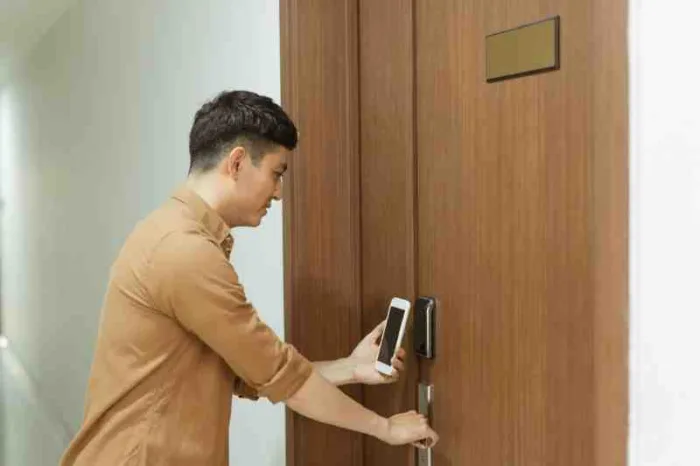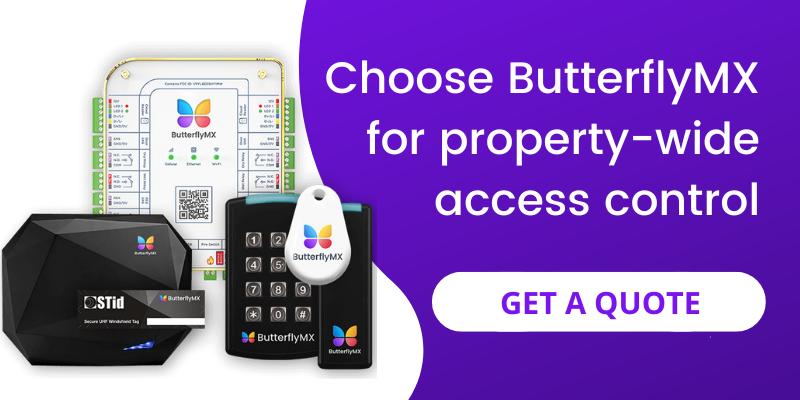Key takeaways
- NFC access control systems are wireless and easy to use. Examples of NFC credentials include key cards, fobs, and even smartphones.
- NFC tags and readers communicate using radio waves and carry more data than other radio-based systems, like RFID. However, one trade-off is that they only work within a short range, usually within a few centimeters.
- Consider the pros and cons of NFC access carefully, especially its limited range and limited features.
- You should consider a keypad or smartphone-based intercom to replace or augment your existing NFC system.
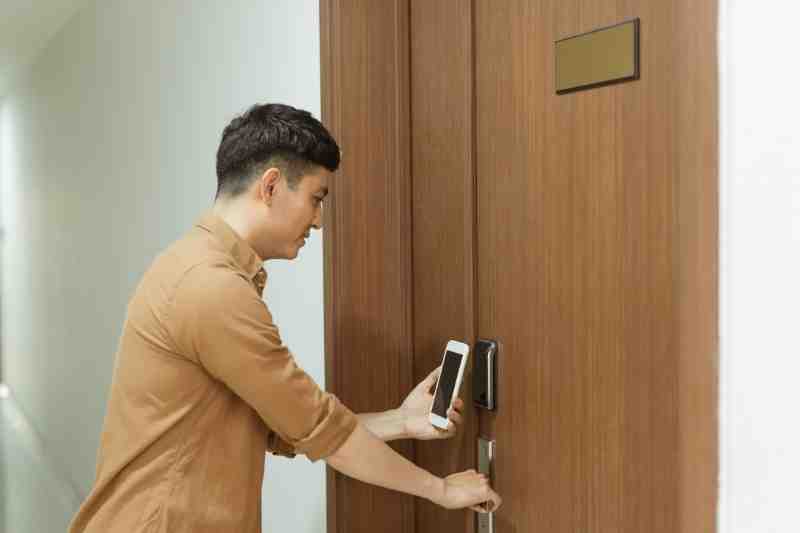
In today’s tech-powered world, you have many options to choose from if you want an electronic way to control property access. RFID access control and NFC access control are two great examples. But which access control system secures your property the best while increasing convenience for staff and tenants?
In this post, we explain what NFC is and how it works. Then, we help you decide if an NFC access system is best for your property. Finally, we offer alternative access control options that might be better.
This post covers:
- What is NFC access control?
- How does NFC door access control work?
- Should you get an NFC access control system?
- NFC access control system alternatives
What is NFC access control?
NFC access control is an electronic way to verify and grant access to tenants using high-frequency radio waves. These radio waves transmit data between a tenant’s credential and a reader, allowing a tenant to gain property access wirelessly.
NFC stands for Near-Field Communication. True to its name, NFC tags and readers must be in close proximity to exchange data. This means that an NFC reader and tag need to be very close to each other—usually in the range of a few centimeters.
As you’ll see, NFC has many applications beyond physical access control. In fact, you can transmit all kinds of data with an NFC connection. NFC-based manufacturers draw on the convenience that makes its technology so prevalent in our everyday lives.
What devices use NFC?
- Public transportation kiosks
- Contactless credit cards
- Concert ticket scanners
- Smartwatches
- Smartphones
- Digital wallets like Google Pay or Apple Pay
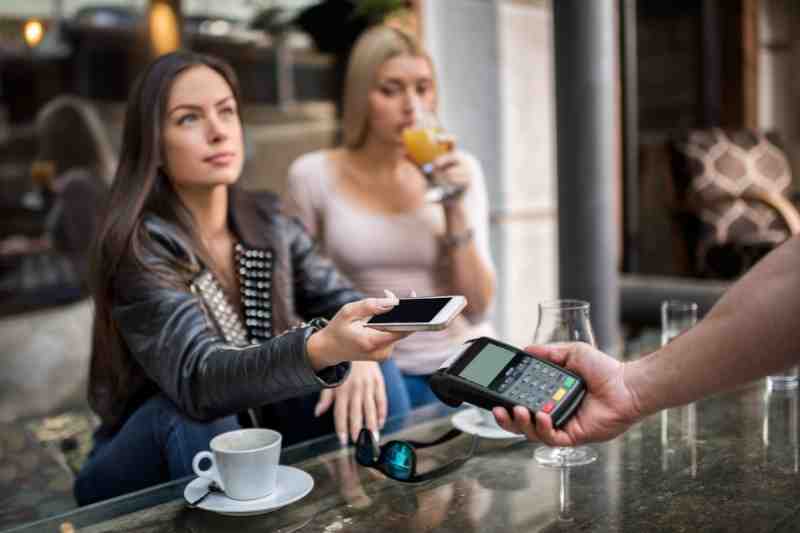
NFC access control systems have these components:
- Tag. Tags come in many shapes and sizes. And since most smartphones today have NFC capabilities, tenants can open doors with an NFC door access app!
- Reader. Readers receive data from tags and work in one of two ways, depending on whether the tag is electrically powered or not. If the tag is not powered, like in a non-battery-powered key or fob, the NFC access card reader door lock gives the tag enough energy to send out data by energizing it with an electromagnetic field. In contrast, a battery-powered tag can send out its own field.
- Control panel. While an NFC door reader takes in the data, a control panel compares it to the information in its database. If the information matches, the control panel grants the tenant entry.
- Electronic lock. The electronic lock disengages according to the direction of the control panel.
Watch how ButterflyMX works:
How does NFC door access control work?
NFC door access control works by using wireless frequencies to establish a connection between a tag and a reader. This process allows the system to verify an NFC tag’s credentials.
But how do you open a door with NFC?
To use an NFC access control system, a tenant holds their access control hardware up to the reader. The reader and the control panel work together to determine if the credential is valid. If it is, the control panel unlocks the door or gate, allowing the tenant to enter.
Under the hood, the high-frequency waves of NFC facilitate high-speed data exchanges between tags and readers. Tags and readers interact in different ways based on whether they’re active or passive.
Active vs. passive in NFC
Passive devices don’t have their own power sources. So, a passive tag depends on the power generated by an NFC access control reader to send the information encoded on it. An example of passive NFC is a key or fob system without a battery.
On the other hand, active NFC tags are battery-powered and can send out their own radio waves and streams of data. An NFC device with enough power and storage, like a smartphone, can switch between active and passive states. This way, both a tag and a reader can store new information.
This flexibility lets the access control system create an audit trail of all door releases in an access control scenario. Then, NFC technology automatically provides a record to both a tenant’s smartphone and your own system.
NFC vs. RFID
You might be wondering about NFC’s relationship to other radio wave-based technologies. Another way for devices to communicate is through RFID — Radio Frequency Identification.
NFC is actually the result of studies and advances in RFID technology. However, even though the two systems are related, they have very different use cases.
For example, RFID systems have farther ranges — an RFID reader and tag can interact at a range of a few feet instead of the centimeter-close range NFC requires.
However, that comes at a trade-off.
RFID radio waves have slower frequencies than NFC radio waves do. While this means that RFID waves can travel farther, NFC waves can carry more data in shorter ranges. In access control, this means that an NFC wave can carry more complex credentials, increasing security.
So is NFC more secure than RFID? Yes, but at the cost of requiring the tag to be in very close proximity to the reader.
Smartphone technology and NFC access control
NFC access control leverages the convenience of smartphone technology to offer secure and seamless entry to buildings or restricted areas. By using an NFC-enabled smartphone as a credential, users can simply tap or bring their device close to a reader to unlock doors, gates, or turnstiles. This eliminates the need for traditional physical keys or cards, reducing the risk of loss or theft while enhancing user convenience.
Smartphone-based NFC access also allows property managers to update or revoke credentials remotely, ensuring real-time security management. With encrypted communication and multi-factor authentication options, this technology not only improves accessibility but also strengthens security, making it a popular choice for modern multifamily buildings and commercial properties.
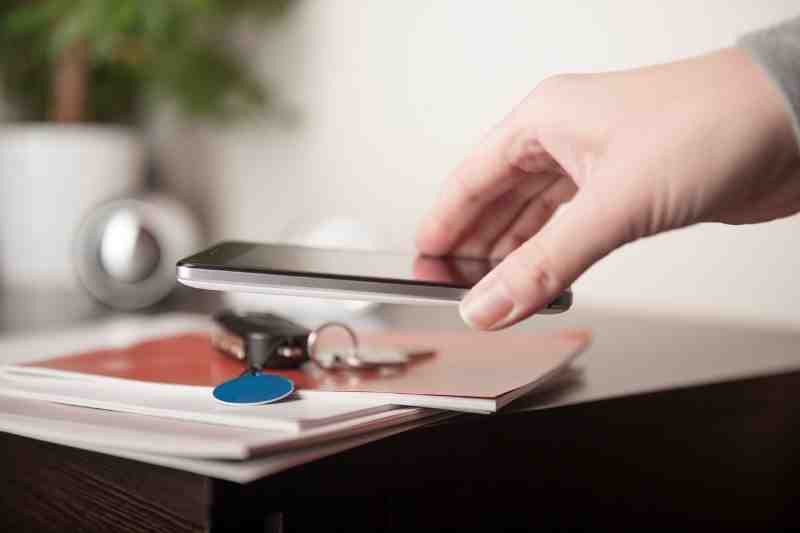
Should you get an NFC access control system?
If you’re curious about NFC access for your own property, you should learn about its benefits and drawbacks first.
Pros of NFC access
- Ubiquitous. Many devices already use NFC technology. So, if you get a smartphone-based NFC access control system, you can rest assured that nearly all tenants these days carry a smartphone in their pocket. You won’t need to hand out credentials.
- Ease of use. Using NFC technology is simple and intuitive. These days, who hasn’t tapped their credit card or used their phone to pay for something? Those things are made possible by NFC. As such, you’ll provide tenants with that same convenience when accessing your property.
- No more lost credentials. This is especially true if you’re using smartphone-based NFC access control. While even the most responsible tenant may misplace a key or fob, they’ll always keep an eye on their phones.
- Eco-friendly. Reduces reliance on disposable plastic keycards, supporting sustainability efforts.
Enhanced security. NFC systems are encrypted, reducing the risk of interception or cloning compared to traditional access methods like magnetic stripe cards.
Cons of NFC access
- Short ranges. Although NFC access control is short-range by design, some of your tenants may find this limiting. For example, access control systems that use Wi-Fi or cellular networks empower tenants to open doors from anywhere with an internet connection, while NFC systems don’t.
- Limited features. While NFC access control systems facilitate simple property access, that’s not the only criterion for a top-notch access control system. Unlike other systems, an NFC access system has no visitor management capabilities, such as letting in recurring guests or one-time delivery drivers.
- Cost. NFC access control costs more than alternative technology such as RFID.
- Risk of signal interference. Environmental factors, such as metallic surfaces or nearby electronic devices, can occasionally disrupt NFC communication.
NFC access control system alternatives
As you’ve seen, contactless access methods using an NFC system have many benefits. However, only you can decide what’s best for your property.
Here are two alternatives to NFC access control that you should consider:
1. Keypad
If you’re interested in the keyless aspects of NFC for door access, keypad access control is a great alternative.
The best keypads simplify access for tenants and staff while enhancing security.
For example, the ButterflyMX keypad lets tenants use their smartphones to open doors. What’s more, it also empowers them to issue one-time PIN codes to delivery couriers for building entry. In addition, staff can view an audit trail with all door releases using the powerful ButterflyMX OS dashboard.
2. Mobile-based intercom
While smartphone-based NFC access systems give tenants the convenience of using their smartphones, they still require phones to be in close proximity to a reader to function. However, other access control systems, such as mobile-based intercoms, let tenants open doors remotely.
Consider a mobile access system that uses a cellular or WiFi connection instead of NFC. This way, a tenant can open the door for their guest anywhere they have an internet connection — whether they’re across town or across the country. As such, tenants don’t need to be on-site to open doors for trusted visitors!
